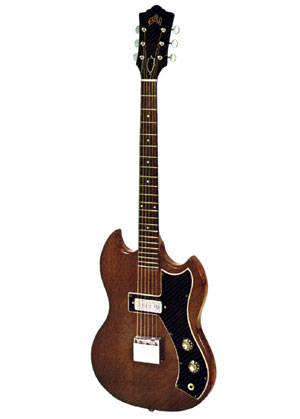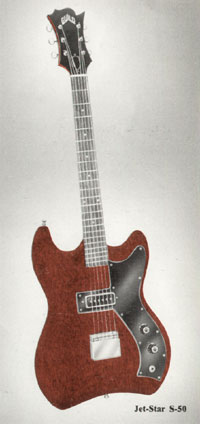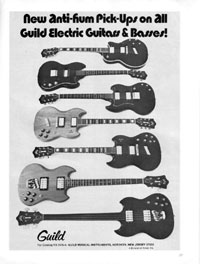
The Guild S-50 was launched in 1963 as the Guild Jet-Star; a cut-down version of the S-100 Polara and Guild S-200 Thunderbird. These were Guild's first solid-body guitars, check them out in the 1963 Guild catalog.
This early version had a quite distinct 'batwing' body style, and a very unique headstock design. Totally original, and somewhat quirky, but a fine looking guitar nonetheless. The Guild Jet-Star kept this style until the end of the decade, although there were subtle changes in hardware, pickups, headstock design etc, and some examples were even equipped with the same Hagstrom vibrato tailpiece as the S-100 and S-200. Production of the 'Jet-Star' S-50 fizzled out as the decade drew to a close, and even theough the Jet-Star was included in 1969 Guild price lists, no solid body guitars at all were included in the 1969 Guild catalog.

But by far the biggest design change occured in 1970, when the Guild S-50 aquired the Gibson SG shape. The names Jetstar and Polara (for the S-100) were dropped at this time, in favour of just the model codes S-50 and S-100. See these new guitars in the 1970 Guild catalog.
It had a mahogany (or alder) body with a set mahogany neck with a rosewood fingerboard. Dot finger board inlays and no inlay on the headstock. It had just one pickup and simplified controls (just volume and tone). Most had a Guild humbucker, though instruments with a single coil pickup may also exist.
The sixties versions had the Guild asymetric headstock, or a 6-a-side headstock very similar the the Gibson Firebird / Thunderbird guitars. It was available in Cherry as standard and in a range of special order colours: Emerald Green, Honey Amber, Ebony Grain and White.
The redesigned SG-style model had a more traditional 3-a-side headstock, and was available in only Sunburst, Cherry, Black, Walnut, or Natural.
The description below comes from the 1966 Guild catalogue - Americas Finest

Pleasingly contoured body is designed for comfort and ease of handling, is 13 3/4" wide. 17 3/4" long, only 1 9/16" deep. Has the famous Guild fast-action neck with 24 3/4" scale and 22 frets.
This instrument has a single built-in Guild "Frequency-Tested" pick-up with individual adjustment screws and separate tone and volume controls. Distinctive new Guild integral tailpiece-bridge combination, with swing-off cover, is adjustable for height, tension and intonation.
This easy-action solid body guitar is highly recommended by teachers for student and other amateur use. Factory-fitted with Guild Strings.
The description below comes from the 1975 Guild electrics catalogue
If one pick-up is all you need, consider this solid body that gives you the essentials for both lead and rhythm playing. You get the same Guild Humbucking Pick-Up as on the other guitars in the "S" series, the same body shape and quality finish—plus a fine neck and fingerboard. All of this at a moderate price.
Details: Contoured all mahogany solid body. Guild extra-fast, very thin mahogany neck with fully adjustable truss rod. Rosewood fingerboard with inlaid mother-of-pearl position dots. Natural headplate. All hardware chrome plated. Guild machines. Guild AdjustoMatic 6-way bridge. Tailpiece of solid brass. Black laminated pickguard. 22 frets. Neck joins the body at 18th fret. Guild E-220 Sidebender Strings.
Electronics: Single chrome plated Guild Humbucking Pick-Up with individual adjustable pole pieces for each string and 3-way tilt adjustment for accurate pick-up placement. Separate tone and volume controls.
Dimensions: Body 1 7/8" (32.7 cm.) wide, 16" (40.6 cm.) long, 1 5/16" (3.3 cm.) thin. Overall length 39 3/4" (100.9 cm.). Scale length 24 3/4" (62.8 cm.). Neck width at nut 5/8" (4.1 cm.).
Guild S-60, Guild S-70, Guild S-90, Guild S-100, Guild S-200, Guild S-275, Guild S-300
Electric guitar advertisements originally published from 1971 onwards. Click on the images for larger copies. Check out other vintage Guild advertisements

Guild S-50 - New Anti-Hum Pick-Ups on All Guild Guitars and Basses (1971)
This advert from December 1971 doesn't say too much - rather it lets the guitars do the talking. It does, however, underline the fact that all Guild guitars ship with humbucking rather than the old...
[more]
$1795
$1199
$2490
$1200
$350
$49
$36
€1600
£299
AU $295